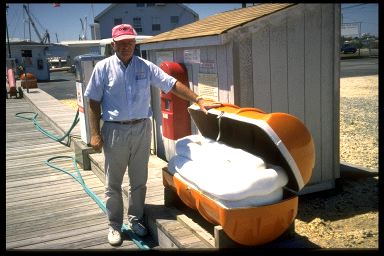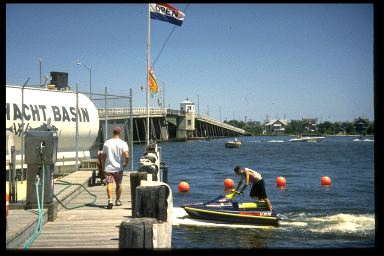
23. Winter Yacht Basin, Inc.
Personal Watercraft Fueling Made Spill-proof
| Location: | 5 Mantoloking Road, Mantoloking, New Jersey 08738 |
| Telephone: | (908) 477-6700; fax: (908) 477-0037 |
| Interviewed: | Kenneth R. Winter, President |
| Owned by: | Kenneth R. Winter |
| Waterbody: | Barnegat Bay, Intercoastal Waterway |
Environmental change
Installing a special floating raft for personal watercraft at the marina's fuel dock virtually eliminated spills during fueling of the small boats.
The full-service marina and boatyard
This New Jersey boatyard was purchased in 1950 by Rudolph and Lydia Winter and became Winter Yacht Basin, Inc.-a full-service boatyard and builder of wooden Jersey Sea Skiffs, with dockage. Over the years the business has evolved into a 110-slip, full-service marina and boatyard, now owned and managed by the Winters' son Ken. The boatyard employs 21 full-time workers year-round, with an additional 4 part-timers during the boating season. The average boat kept in this home port marina is 40 feet LOA; lengths range from 18 feet to 65 feet. Twenty-five percent are sailboats, and 75% are powerboats.
In 1995, the marina was 70% occupied for the season, with the remaining space available for docking transients cruising the Intracoastal Waterway. On a typical high-use summer weekend, about 60% of the boats were in use, with about 25% occupied overnight. There were no liveaboards. The boating season typically runs from April to November.
Sited beside a bridge, the yacht basin is on the narrow Intracoastal Waterway channel, ideally located for gas and diesel sales at its fixed fuel dock. A self-serve pumpout station is available adjacent to the super-clean restrooms. A ship's store, laundry, and yacht brokerage round out the marina services.
The boatyard services include haulout/launching with a travel lift, forklift, and marina railway. The full range of repair services include fiberglass, hulls, engines, electrical, sailboat rigging, wood work, custom cabinet making, painting, and bottom cleaning. Prior to purchase by the Winters, the boatyard had been a boat-building company since 1928. Within a 2-mile radius there are 3 other marinas, all serving an estimated 1,500 boats.
Management measures
Winter Yacht Basin complies with the marina management measure for fueling station design, as well as the measures for shoreline stabilization, storm water runoff control, sewage facility, maintenance of sewage facilities, solid waste, liquid materials, petroleum control, boat cleaning, and public education.
Costs/benefits
Winter Yacht Basin's two new personal watercraft drive-on docks cost $3,138 installed, but brought in $6,370 extra fuel income just in the first boating season. They virtually eliminated the small fuel spills that had occurred at most fill-ups. With an amortized annual cost of $406, plus a maintenance cost of $400, the net 1995 income was $5,560.
Environmental improvements
Having a well-located fuel dock, Winter Yacht Basin attracts boats of all types and sizes, from small personal watercraft (PWCs) up to large yachts cruising the waterway. But with such a mix of boats being serviced, Ken Winter said, "Frankly, I was not happy with PWCs for two reasons:
- When large boats arrived to buy 500 to 1,000 gallons of fuel, the dock often was occupied with a couple of personal watercraft buying only 5 gallons each, and we had to keep the big boat waiting.
- Environmentally, with the small PWCs rocking from side to side, it was nearly impossible to fill them without some fuel spilling, and they often got some water in their fuel tanks."
"We solved both problems in May 1995 by buying and installing two SportPort drive-on docks at the east end of our fuel pier. These were primarily made to store jet skis and wave runner boats up and out of water. But we thought they would work well at our fuel dock. Our two 4-foot by 10.5-foot floats, bolted side by side, were connected to PVC pipes to allow them to ride up and down with the tide," Winter explained.
"When a PWC arrives to buy gasoline, the usually young driver nudges the bow onto the front of the float, gives it the gas, and the craft rides up completely onto the dry polyethylene platform. The operator steps off the boat onto the dock, is handed the fuel nozzle, and fills the small tank without any spilling because it so stable. When done, the driver mounts the PWC, starts the motor, and leans way back, and the boat slides into the water."
"The best part for me is that we placed those drive-on floats at the end of our fuel pier, which is too narrow for large boats to use. All the conflicts at the big boat fuel dock are gone. Because the PWC users find our drive-on floats so easy and fun to use, they come from all over, and we are selling much more fuel to them. And since virtually all the fuel spills have stopped, we have no cleanup costs."
| Winter Yacht Basin owner Ken Winter keeps spill control equipment handy at the fuel dock. |
 |
The two SportPort floats were purchased for $1,600 in 1995. The cost for installing them was $1,158 for labor, plus $380 for a separate sign. "We haul out these docks for the winter and launch them in the spring. Thus our maintenance cost is about $400. When we figured it out, we sold $6,366 more fuel to PWCs than we did last year!" a smiling Winter exclaimed. "And we'll probably do better next year. Now I like the personal watercraft business."
Other improvements and benefits
The first impression one gets visiting Winter Yacht Basin is how ultra neat and clean it is. The grounds are immaculate. No litter can be found anywhere. The restrooms sparkle. Many pretty flower beds are scattered around the facility-all well-tended and in colorful bloom. To do this the yard has one full-time, year-round employee who only cleans the grounds, buildings, gardens, and work areas. Winter said, We make this a nice place to come to."
The second impression is the range of 17 different sized buildings scattered about the property. One is the main office and ship's store, while the others are for either indoor boat repair or storage. Every one is neat and clean. "More and more customers want good repairs and service, but done in environmentally friendly ways," said Winter. "A boat is a further expression of one's personality, and the owner of a $1.3 million Hatteras doesn't want messy work. My employees are thinking cleaner and that is reflected in higher-quality work. For example, I find that a mechanic who works cleaner is generally more detail-conscious. Our customers know when they come here that they will pay for clean, quality work, but they also know they will not need to come back to have the job done again to make it right."
The yard's underground fuel tanks were removed and replaced in 1993 with above-ground tanks set in concrete containment. Winter said, "I expect all the fuel tank replacement to have payout in 8 years."
The marina has a spill control plan available in the main office, with copies
in the fuel dock house, parts manager's office, and yard office. Spill control booms
are easily accessible on the fuel dock from brightly colored fiberglass lockers formerly
used for ship life rafts. For easy access, cleanup pads are available in the dock
house there, while three emergency response bags are waiting in the parts manager's
office for bigger spills, along with the emergency response handbook. Oil, antifreeze,
and waste oil containers are stored indoors within bermed containment areas. Regular
yard maintenance is conducted to ensure all used and unused supplies are returned
or disposed of in a proper manner. Until Ken Winter decides on a long-term solution
to control suspended solid runoff from the hull pressure-washing area, he is effectively
using a row of common hay bales, which are very good temporary filters. Storm drains
are being fitted with 1/4-inch mesh hardware cloth baskets with inserted filter material.
| Personal watercraft were a broblem at Winter Yacht Haven until two side-by-side drive-on docks were installed on Barnegat Bay, New Jersey. |  |
All employees and customers receive a copy of Winter Yacht Basin's best management practices (BMP) and sign a release that they have read and understood the BMPs. Awareness training programs are held several times a year to teach yard employees to recognize sources of pollution and report them to their supervisors.
"We have always had the reputation of a clean boatyard, but we are even cleaner now." And Ken Winter has a list of several more ways he plans to improve the marina's environmental impacts over the next few years.
Equipment source
- PWC drive on dock: SportPort; manufactured by Zeppelin Marine 1801 Spanish Trail, Delray, FL 33483.
http://www.epa.gov/owow/NPS/marinas/ch23.html
This page last updated October 4, 1999


